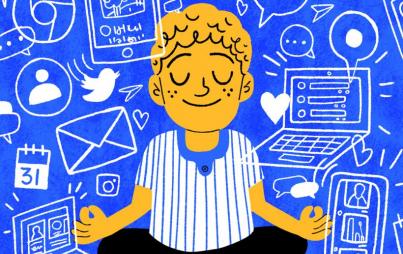
It’s like a care package, only you assemble it for yourself and open it up when you’re having a bad day. Image: Annie Spratt/Unsplash.
I no longer have the “I don’t know what to do for self-care” excuse, because I have an entire box of things I can utilize at any moment.
I think everyone, whether they have a mental illness or not, knows what it’s like to be in total despair and have no idea what to do about it. You’re curled up in bed, you don’t want to move, and you desperately wish you knew how to make things better.
While I don’t have the cure to depression (damn, I really wish I did), there are a few tricks that have helped me when I reached that now what? moment.
These mental health hacks, while they aren’t going to fix everything, are great to have in place and they encourage us to make good decisions for ourselves when we’re struggling. They’re simple, yes, but incredibly helpful.
So here are three mental health hacks that have made a difference for me — and could make a difference for you, too.
1. A distraction plan
I learned this one from my DBT workbook. It’s been hugely important in getting me to move away from self-destructive habits and to start relying on self-care when I’m struggling.
Here’s the gist of it: You come up with 10 things that you can do when you’re feeling down to boost your mood. Write it down on a note card and keep it handy. Bonus, mine also includes a suicide hotline number at the bottom, just in case.
My distraction plan includes going for a walk to get a coffee or a smoothie (alone or with a friend), watching a funny show, wrapping myself in a soft blanket and listening to a new podcast, taking a long shower or bath, playing a game or assembling a puzzle, and squeezing an ice cube while counting my breaths.
Every time I’m feeling despondent, I force myself to try to do at least one thing from that list.
It sounds silly, but sometimes all it takes is one or two of these activities to get my mood to a more manageable place.
There’s an awesome video by Kati Morton all about distraction techniques and distraction plans that I highly recommend watching. The video can teach you how to develop one of these plans.
If you don’t have a distraction plan in your repertoire, it doesn’t hurt to get one!
2. A crisis calendar
I have a special calendar in my Google Calendar app that I call my “crisis calendar.”
In it, I’ve entered in any relevant support groups, walk-in classes or activities, and club or spiritual meetings that could boost my mental health.
That way, if I’ve hit a rough patch with my mental health, I know where to go to get support or do something healing.
My calendar includes two queer support groups, two bipolar support groups, donation-based pilates classes, and a cardio dance class. I try to give myself the option of seeking out emotional support, or simply doing something physical with others to get my endorphins going and socialize a little.
Do I go to these events every week? Nope. But when I’m feeling down, I pull up the calendar and try to commit to one or two events that week.
I also set reminders an hour before, just to remind myself that the option is there for me.
It’s comforting to know that if I’m having a hard time, I’ll always know where to go on any given day.
For those of us who are lucky enough to have resources in our own backyards, we often don’t consider what's available to us and how we might use it. When struggling with our mental health, we tend to think we should go it alone – but the truth is, our communities may, in fact, have a lot to offer us.
If you aren’t sure what resources are available to you, your local NAMI chapter is a great place to start. If you have a therapist, they can also point you in the right direction.
3. A self-care rescue box
One of the problems I consistently had when it came to self-care was following through. I’d get depressed, and instead of doing something to take care of myself, I’d insist that it took too much energy to find something to do... so I’d opt to stay in bed.
As you probably can imagine, staying in bed made things worse.
I decided I needed to simplify; I needed to make self-care easier and more accessible. So I decided to create a self-care rescue box.
What the heck is it? A self-care rescue box is a box that you fill with items that are part of your self-care routine. It’s like a care package, only you assemble it for yourself and open it up when you’re having a bad day.
Mine includes a heating pad, two uplifting books, lotions and massage bars, a manicure kit, video games, a DVD collection of my favorite television series, a box of my favorite tea, an emergency chocolate bar, candles, board games, and all sorts of comforting things.
I no longer have the “I don’t know what to do for self-care” excuse, because I have an entire box of things I can utilize at any moment.
On my bad days, I try to grab at least one thing from the box and use it. It operates as a great distraction and I get a little boost just having a box filled with stuff that I love.
And honestly? I can’t believe I didn’t think of it sooner.
♦♦♦
The truth is, there is no one “hack” that can cure mental illness or make your struggles go away.
However, there are tools we can add to our tool belts that make the tough days just a little bit easier to cope with.
Whether it’s keeping ourselves distracted, seeking out support, or finding new ways to care for ourselves, it’s always good to keep in mind that we have options, no matter what life throws at us.
Do you have any “mental health hacks” that have helped you? Share them below in the comments. I’d love to hear them!








